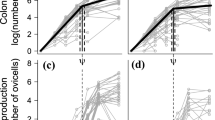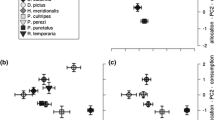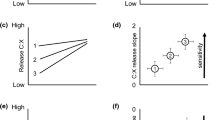Abstract
Body size has great influence on feeding, reproduction, and ecological importance. This study measures growth, reproduction, and feeding for several northeastern Pacific intertidal invertebrates that have indeterminate growth. In all species studied, linear size (length, diameter) showed asymptotic growth fit by the von Bertalanffy growth function, supporting the notion that less energy is allocated to growth with age because of increased reproduction. However, these same species displayed a continuous, roughly linear increase in volume with age. Both reproductive output and food intake were shown to scale proportionally with volume. This indicates that some species with indeterminate growth do not reduce energy allocation to growth with age but instead display continuous volumetric growth that facilitates increases in feeding rate and reproductive output with age and size. A simple allometric model is proposed to describe constant volumetric growth rates and linear increases in reproduction with age.






Similar content being viewed by others
References
Barnes JR (1972) Ecology and reproductive biology of Tonicella lineata (Wood, 1815) (Mollusca-Polyplacophora). Dissertation, Oregon State University
Berg S, Christianou M, Jonsson T, Ebenman B (2011) Using sensitivity analysis to identify keystone species and keystone links in size-based food webs. Oikos 120:510–519
Boolootian RA (1964) On growth, feeding and reproduction in the chiton Mopalia muscosa of Santa Monica Bay. Helgol Wiss Meeresunters 11(3–4):186–199
Brown KM, Quinn JF (1988) The effect of wave action on growth in three species of intertidal gastropods. Oecologia 75:420–425
Cattaneo-Vietti R, Chiantore M, Albertelli G (1997) The population structure and ecology of the Antarctic scallop Adamussium colbecki (Smith, 1902) at Terra Nova Bay (Ross Sea, Antarctica). Sci Mar 61(suppl. 2):15–24
Chase JM (1999a) Food web effects of prey size refugia: variable interactions and alternative stable equilibria. Am Nat 154(5):560–571
Chase JM (1999b) To grow or to reproduce? The role of life-history plasticity in food web dynamics. Am Nat 154(5):571–586
Chen Y, Jackson DA, Harvey HH (1992) A comparison of von Bertalanffy and polynomial functions in modeling fish growth data. Can J Fish Aquat Sci 49:1228–1235
Clauss MJ, Aarssen LW (1994) Phenotypic plasticity of size—fecundity relationships in Arabidopsis thaliana. J Ecol 82(3):447–455
Cooper EE (2010) Population biology and reproductive ecology of Chlorostomsa (Tegula) funebralis, an intertidal gastropod. Dissertation, University of Oregon
Crespi BJ, Teo R (2002) Phylogenetic analysis of the evolution of semelparity and life history in salmonid fishes. Evolution 56(5):1008–1020
Digel C, Riede JO, Bose U (2011) Body sizes, cumulative and allometric degree distributions across natural food webs. Oikos 120:503–509
Ebert TA (2008) Longevity and lack of senescence in the red sea urchin Strongylocentrotus franciscanus. Exp Gerontol 43:734–738
Ebert TA, Lees DC (1996) Growth and loss of tagged individuals of the predatory snail Nucella lamellosa in areas within the influence of the Exxon Valdez oil spill in Prince William Sound. Am Fish Soc Sym 18:349–361
Ebert TA, Russell MP (1992) Growth and mortality estimates for red sea urchin Strongylocentrotus franciscanus from San Nicolas Island, California. Mar Ecol Prog Ser 81:31–41
Engen S, Saether BE (1994) Optimal allocation of resources to growth and reproduction. Theor Pop Biol 46:232–248
Essington TA, Kitchell JF, Walters CJ (2001) The von Bertalanffy growth function, bioenergetics, and the consumption rates of fish. Can J Fish Aquat Sci 58:2129–2138
Forseth T, Ugedal O, Jonsson B (1994) The energy budget, niche shift, reproduction and growth in a population of Arctic charr, Salvelinus alpines. J Anim Ecol 63(1):116–126
Frank PW (1965a) Growth of three species of Acmaea. Veliger 7(3):201–202
Frank PW (1965b) Shell growth in a natural population of the turban snail, Tegula funebralis. Growth 29:395–403
Gibbons MM, McCarthy TK (1986) The reproductive output of frogs Rana temporaria (L.) with particular reference to body size and age. J Zool 209(4):579–586
Gonor JJ (1973) Reproductive cycles in Oregon populations of the echinoid, Strongylocentrotus purpuratus (Stimpson): I. annual gonad growth and ovarian gametogenic cycles. J Exp Mar Biol Ecol 12:45–64
Grupe BM (2006) Purple sea urchins (Strongylocentrotus purpuratus) in and out of pits: the effects of microhabitat on population structure, morphology, growth, and mortality. Thesis, University of Oregon
Gurney WSC, Middleton DAJ, Nisbet RM, McCauley E, Murdoch WW, De Roos A (1996) Individual energetics and the equilibrium demography of structured populations. Theor Pop Biol 49:344–368
Heino M, Kaitala V (1996) Optimal resource allocation between growth and reproduction in clams: why does indeterminate growth exist? Funct Ecol 10(2):245–251
Heino M, Kaitala V (1999) Evolution of resource allocation between growth and reproduction in animals with indeterminate growth. J Evol Biol 12:423–429
Hines AH (1982) Allometric constraints and variable of reproductive effort in brachyuran crabs. Mar Biol 69(3):309–320
Hood PB, Schlieder RA (1992) Age, growth, and reproduction of gag, Mycteroperca microlepis (Pisces: Serranidae), in the eastern Gulf of Mexico. Bull Mar Sci 51(3):337–352
Jokela J (1997) Optimal energy allocation tactics and indeterminate growth: life-history evolution of long-lived bivalves. In: Streit B, Stadler T, Lively CM (eds) Evolutionary ecology of freshwater animals. Birkhauser-Verlag, Germany, pp 179–196
Kenny R (1969) Growth characteristics of Acmaea persona. Veliger 11(4):336–339
Kooijman SALM (2000) Dynamic energy and mass budgets in biological systems. Cambridge University Press, Cambridge
Kozlowski J (1996a) Energetic definition of fitness? Yes, but not that one. Am Nat 147(6):1087–1091
Kozlowski J (1996b) Optimal allocation of resources explains interspecific life-history patterns in animals with indeterminate growth. Proc R Soc Lond B 263(1370):559–566
Kozlowski J, Gawelczyk AT (2002) Why are species’ body size distributions usually skewed to the right? Funct Ecol 16:419–432
Kozlowski J, Teriokhin AT (1999) Energy allocation between growth and reproduction: The Pontryagin Maximum Principle solution for the case of age- and season-dependent mortality. Evol Ecol Res 1:423–441
Kozlowski J, Czarnołeski M, Danko M (2004) Can optimal resource allocation models explain why ectotherms grow larger in cold? Integr Comp Biol 4:480–493
Lester NP, Shuter BJ, Abrams PA (2004) Interpreting the von Bertalanffy model of somatic growth in fishes: the cost of reproduction. Proc R Soc Lond B 271:1625–1631
Lively CM (1986) Competition, comparative life histories, and maintenance of shell dimorphism in a barnacle. Ecology 67(4):858–864
Lord JP (2011) Larval development, metamorphosis and early growth of the gumboot chiton Cryptochiton stelleri (Middendorff, 1847) (Polyplacophora: Mopaliidae). J Moll Stud 77:182–188
Lord JP (2012) Longevity and growth rates of the gumboot chiton Cryptochiton stelleri, and the black leather chiton Katharina tunicata. Malacologia 55(1) (in press)
Middleton DAJ, Gurney WSC, Gage JD (1998) Growth and energy allocation in the deep-sea urchin Echinus affinis. Biol J Linn Soc 64:315–336
Miyazaki N (1977) Growth and reproduction of Stenella coeruleoalba off the Pacific coast of Japan. Sci Rep Whales Res Inst 29:21–48
Mulder C, Vonk JA, Hollander HAD, Hendriks AJ, Breure AM (2011) How allometric scaling relates to soil abiotics. Oikos 120:529–536
Paloheimo JE, Crabtree SJ, Taylor WD (1982) Growth model of Daphnia. Can J Fish Aquat Sci 39:598–606
Peters RH (1983) The ecological implications of body size. Cambridge University Press, New York
Rall BC, Kalinkat G, Ott D, Vucic-Pestic O, Brose U (2011) Taxonomic versus allometric constraints on non-linear interaction strengths. Oikos 120:483–492
Ricker WE (1975) Computation and interpretation of biological statistics of fish populations, bulletin 19. Department of the Environment, Fisheries and Marine Service, Ottawa
Rinke K, Hulsmann S, Mooij WM (2008) Energetic costs, underlying resource allocation patterns, and adaptive value of predator-induced life-history shifts. Oikos 117(2):273–285
Rogers-Bennett L, Rogers DW, Bennett WA, Ebert TA (2003) Modeling red sea urchin growth using six growth functions. Fish Bull 101:614–626
Sebens KP (1987) The ecology of indeterminate growth in animals. Ann Rev Ecol Syst 18:371–407
Sebens KP (2002) Energetic constraints, size gradients, and size limits in benthic marine invertebrates. Integr Comp Biol 42:853–861
Shields JD (1991) The reproductive ecology and fecundity of Cancer crabs. In: Wenner A, Kuris A (eds) Crustacean egg production. A.A. Balkema, Rotterdam, pp 193–213
Steffani CN, Branch GM (2003) Growth rate, condition, and shell shape of Mytilus galloprovincialis: responses to wave exposure. Mar Ecol Prog Ser 246:197–209
Steinberg PD (1985) Feeding preferences of Tegula funebralis and chemical defenses of marine brown algae. Ecol Monogr 55(3):333–349
Suchanek TH (1981) The role of disturbance in the evolution of life history strategies in the intertidal mussels Mytilus edulis and Mytilus californianus. Oecologia 50:143–152
Thompson RJ (1979) Fecundity and reproductive effort in the blue mussel (Mytilus edulis), the sea urchin (Strongylocentrotus drobachiensis), and the snow crab (Chionoecetes opilio) from populations in Nova Scotia and Newfoundland. J Fish Res Board Can 36:955–964
Von Bertalanffy L (1938) A quantitative theory of organic growth (inquires on growth laws II). Hum Biol 10:181–213
Von Bertalanffy L (1957) Quantitative laws in metabolism and growth. Q Rev Biol 32:217–231
Webb TJ, Dulvy NK, Jennings S, Polunin NVC (2011) The birds and the seas: body size reconciles differences in the abundance-occupancy relationship across marine and terrestrial invertebrates. Oikos 120:537–549
Winship AJ, Trites AW, Calkins DG (2001) Growth in body size of the Steller sea lion (Eumetopias jubatus). J Mammal 82(2):500–519
Woodward G, Ebenman B, Emmerson M, Montoya JM, Oleson JM, Valido A, Warren PH (2005) Body size in ecological networks. Trends Ecol Evol 20(7):402–409
Yates KR (1989) Notes on the feeding ecology of the gumboot chiton, Cryptochiton stelleri (Middendorff). Dissertation, Oregon State University
Acknowledgments
Thanks to Jessie McGrath for her help conducting C. funebralis feeding experiments and Cynthia Trowbridge for suggestions on presentation of the data and format of the manuscript. This material is based upon work supported by the National Science Foundation under Grant No. 0638731, 2009–2010, PIs Alan Shanks and Jan Hodder. Collections were made with Oregon Department of Fish and Wildlife collecting permit #15387.
Author information
Authors and Affiliations
Corresponding author
Additional information
Communicated by S. Connell.
Electronic supplementary material
Below is the link to the electronic supplementary material.
Rights and permissions
About this article
Cite this article
Lord, J.P., Shanks, A.L. Continuous growth facilitates feeding and reproduction: impact of size on energy allocation patterns for organisms with indeterminate growth. Mar Biol 159, 1417–1428 (2012). https://doi.org/10.1007/s00227-012-1918-5
Received:
Accepted:
Published:
Issue Date:
DOI: https://doi.org/10.1007/s00227-012-1918-5




